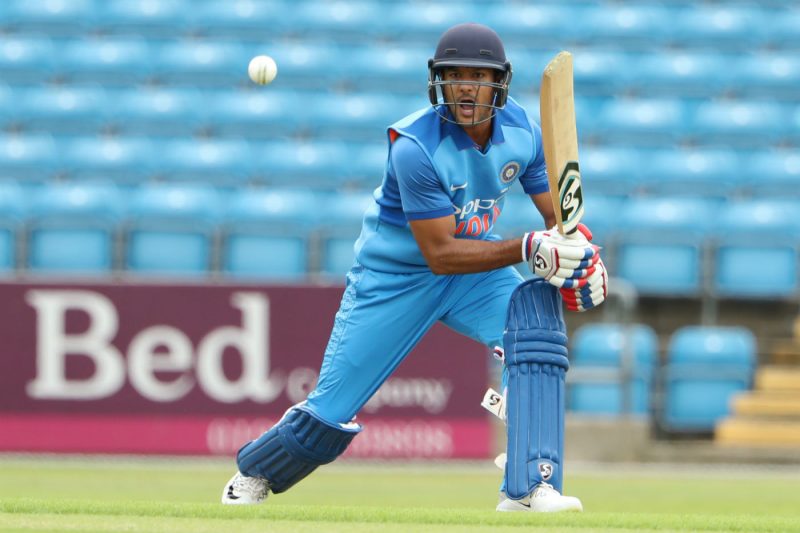At the moment, he is probably the best batsman to have never played for India. Sitting on a tally of 2162 runs across all domestic formats in the year 2017 -18, Mayank Agarwal has not only staked a claim for a decent trial with the national team but has made the national selectors look incompetent with their questionable selection barometer. The last time an Indian batsman scored over 1400 runs in a single domestic season, he went on to become a ‘Very Very Special’ player in world cricket. That the final say in the selection matters lies with the captain and the coach is a given. However, never before has such a colossal of performance that lasted over a year been overlooked.

It must be difficult being Mayank these days. That sense of accomplishment the first time you are informed by the chairman of national selection committee about being in the reckoning must have already turned into one of bewilderment. Though there is only little Mayank can do about the situation except keep churning out those big numbers out in the middle. This cannot, however, be merely labelled a selection gaffe and brushed under the carpet. It is not as if there are no vacant slots in the current Indian team’s limited overs side. So then, why do we keep hearing about selection anomaly stories in Indian cricket frequently? Is it because there are far too many good players vying for a national spot? Maybe, but with the globalization of the game, there are far too many international matches happening every few weeks and one cannot expect the same set of eleven players to be participating in all of the events. You need different players for different formats and for different tournaments and every prolific domestic player is bound to get his due at some stage. Then, where or why do the selectors go topsy-turvy? In fact, there are as many kinds of potential selection slipups as there are facets to the art of selecting cricket teams across all formats.
This is not the first time that a high performing individual at the domestic level has had to wait for his rightful turn. While some went on to don the national colors, for others that opportunity never came, albeit for various reasons.

If you were to go back in time, K.N Ananthapadmanabhan, once known as the Anil Kumble of Kerala cricket in the 90s would have one such story to tell. Having scalped 344 wickets in first-class cricket with 25 five-wicket hauls, his elevation to the senior team was a no-brainer, one would think.
However, for KN, there was a small matter of competing for a slot with Anil Kumble himself who was in the process of redefining the art of bowling leg spin with his own interpretation of the skill. KN almost resigned to his fate until the 1997 tour of the West Indies. In that tour, when an injured Javagal Srinath had to pull out of the series, the team management was looking for a spinner as his replacement, considering the dry weather conditions that prevailed then.
The situation seemed ripe for K.N’s induction into the Indian team, but what followed was a selection exercise, the logic behind which remains mysterious to this day. A novice by the name Noel David, who was finding it difficult to find a place even in the Hyderabad X1, was named as Srinath’s replacement. In fact, the then captain Sachin Tendulkar famously went on to ask ‘Who is this Noel David?’, after the selection announcement.

It is true that the limits of wisdom that prevailed then have transcended onto the subsequent selection panels and Indian cricket did lose a few exceptional individual performers to the system, but to the selectors’ defense, not all of them. Mumbai stalwart Amol Muzumdar was trying to break in when Sourav Ganguly and Rahul Dravid announced their arrival in test cricket while, the Hyderabad spin king Kanwaljit Singh did not get a look in, as Kumble had cemented his spot in the national team. There are many such names who only had their destinies to blame. None of these selection trip-ups affected Indian cricket as those selected went on to make cricket’s history richer. Could Amol or Kanwaljit have outperformed them is a narrative for a different day
Then there is the third type of selection blunder that piques one’s cricketing curiosity the most. This bungle could rather be classified as an act you commit out of over-excitement, owing to lack of deep understanding of the requirements of the game or by simply bowing to the diktats of the team management.
For instance, Rohit Sharma is arguably one of the best-limited overs openers going around in the world at the moment. Despite having a technical deficiency in his game, a lackadaisical approach against the moving ball outside the off stump, he has managed to become this dominant batting force, the ‘Hitman’, as they call him. You may get away with this approach in limited overs cricket, but test cricket is far less forgiving. A deft dab to the third man boundary in an ODI will be gobbled up by the second, third, fourth slip or even the short gully in the longer format. He was, indeed, on multiple occasions. When he seemed to have gone back to the drawing board working on this shortcoming, Rohit developed a weakness against deliveries that jagged back in, often trapping him in front of the stumps. Sadly, he has never been able to make an impression in test cricket despite getting a fairly long rope.

However, there is this seemingly lack of willingness on the selectors’ part to acknowledge this very aspect of his game. This needs to be addressed before he could be considered again for test cricket, particularly outside the subcontinent. Regardless, time and again, he gets drafted into the test squad on the back of a few impressive knocks in the limited overs format only to fail over and over. Performance wise, he has provided enough sample size for the selectors over the last decade to have missed out on dissecting his game and assessing this frailty. In the recently concluded test series against the South Africans in South Africa this year, Sharma looked all at sea. It appeared as if he had no clue where his next test run would come from. Strangely, he did not even appear to have a game plan except hoping the hostile environment would wane down on its own.
Another category of selection errors occurs when the selectors have misplaced priorities as to which tournaments the players need to be given weightage for their performances. The likes of Manpreet Gony, Parvinder Awana, Mohit Sharma, Karn Sharma, Axar Patel, and Naman Ojha are all beneficiaries of one such flawed policy, all getting a look in, based on their IPL performances.
On the face of it, the thinking behind such a move cannot be banished. IPL comes with its own share of scrutiny and even the best of international stars at times have displayed vulnerability under searing pressure the tournament brings along with it. However, none of these players, barring Axar Patel, could withstand the pressures of international cricket and faded away into oblivion as quickly as they had appeared. Sadly, most of these players were considered for ODIs, instead of the T20 format where they had proved their worth. Only Hardik Pandya seems to have made this transition successfully, so far at least, but the jury is still out on his credentials as a test cricketer.

Then there is the case of Kuldeep Yadav. Yadav’s selection into the test squad for the ongoing England series is a classic example of one born out of wishful thinking, of getting excited at the prospect of a positive outcome that one envisions based on hope not necessarily on data. He was extremely successful in the limited overs games against the Englishmen this year, but, his performances came in conditions that were akin to a dry Indian summer where the ball gripped and turned. Test cricket, though, in the UK is literally a different ball game, especially for the bowlers where the red Dukes ball tends to swing and seam more than SG cricket balls back in India. The Indians learned it the hard way with Kuldeep’s inclusion in the Lord’s test where he found the going extremely tough. You would do well to know that in test cricket, you would have to live with your mistakes five times over when compared to an ODI.
The selection committee missed yet another trick in the same series by naming Manish Pandey in the T20 squad instead of the ODI squad. Though Manish has played a few memorable innings in the IPL, his style of knocking around the ball initially to settle down before going on the rampage is ideally suited for the 50 overs format. This is the method that worked like a charm for him in the recently concluded quadrangular series for India B team, where he had scores of 117*, 95*, 21* and 73*. If not by his own admission, the selectors ought to have seen his struggles in the recently concluded IPL, where he found it difficult to go after the bowlers from the word go. In the T20s against South Africa this year, he approached each of his innings with caution initially, where he was going at a run a ball, a method any middle order batsman ought to adopt only in the limited overs. He is one player who is in danger of being lost to the wrong format of the game and not the system, ironically.

What then is the solution to Indian cricket’s selection blues? Rahul Dravid cannot be the answer to all problems ailing Indian cricket. The answer lies in a systematic approach to removing the muck at various levels. Firstly, it should start with the decentralization of power that currently lies with the all-powerful two-member team management of the Indian cricket team. Secondly, a consensus amongst all the stakeholders is required including both the administrators and the cricketers that the performances in domestic cricket be considered the Holy Grail for a national call-up.
Lastly and most importantly, the selection panel needs to have members who have not just played cricket at the highest levels but those whose opinions about the game are revered. A partial first step of sorts was taken in the right direction in 2016 when the BCCI was forced by the Lodha panel to do away with the zonal system. Partial, as the Lodha panel insisted on having members with test match experience.
However, the BCCI veered by picking players who have ODIs and first-class cricket experience. If you have followed the game long enough, you would know that it is not the numbers alone that indicate the ability of a player. A test cricketer of the ability of Dilip Vengsarkar once felt a 19-year-old boy, despite not having stacked up favorable numbers, needs to be drafted into the India squad going by intangible selection parameters. The attributes Dilip used to gauge cannot be documented as a selection criterion.
When the youngster once scored an unbeaten 120 against New Zealand A in Brisbane, Dilip judged him by the sound the young boy’s bat made with the ball. He judged his mental fortitude when he decided to pad up to play a match-saving innings before performing his father’s final rites. Reasons not weighing up enough, one may think to pick a player, but it is the immense respect that Dilip commands amongst his peers that made the boy’s selection possible for the tour of Sri Lanka in 2008. One should not forget that Dilip had the gumption to go against the wishes of Dhoni and Kirsten who tried to resist his inclusion.

Dilip very well knew he had seen something special when he wanted to fast-track him and his colleagues responded with an ‘As you say Dilip Bhai’, creating a selection story, one for posterity, the selection of Virat Kohli.







